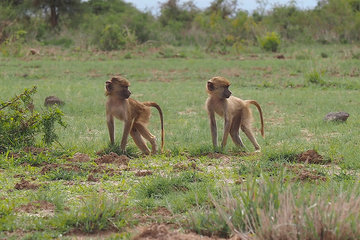An ear for frogs
Jozefien Van de Velde from the Max Planck Institute for Plant Breeding Research in Cologne traveled to Australia for two months in search of frogs in the outback. This was no easy task, as her study subjects are nocturnal, hide underground in dry conditions, and only emerge after heavy rain.

The ways in which animals adapt to their environment in order to survive have always fascinated me. For my doctoral thesis, I am researching frogs of the genus Neobatrachus, which are found in the arid regions of Australia. To survive periods of drought, they burrow up to one meter underground and surround themselves with a kind of cocoon that protects them from drying out. This allows them to survive for several years if necessary; they only come to the surface to reproduce once there has been sufficient rainfall.
Interestingly, three of the nine known Neobatrachus species are polyploid – each of their cells contains four sets of chromosomes. Most animals, including humans, are diploid. In diploid organisms, each chromosome is present in duplicate, once as a maternal copy and once as a paternal copy. Polyploid species often exhibit different characteristics from their diploid relatives. For example, some amphibians with “additional” chromosomes are less sensitive to harsh climates and drought and have therefore been able to colonize mountain or desert regions.
In general, polyploidy is common in plants, which is why my frog project is based at the Max Planck Institute for Plant Breeding Research. I am particularly interested in universal molecular mechanisms: how do the many chromosomes within the cell nucleus coordinate? This coordination is crucial for cell division, during which the genetic material has to be precisely distributed to the daughter cells. To find out which genes play a role in this process, I am comparing diploid and polyploid Neobatrachus species.
Our Max Planck research group is collaborating with the Western Australian Museum in Perth and the Southern Australian Museum in Adelaide. Both museums store frozen Neobatrachus tissue samples from which I was allowed to extract DNA; I also searched for frogs in the field. In Australia, you are required to take a first aid course to obtain the necessary authorization from the nature conservation authority to catch frogs. After this course, you are well equipped for conducting fieldwork in the outback: for example, the course teaches you how to distinguish between poisonous and non-poisonous spiders and what to do in an emergency after a snake bite. There were many Australians on the course who had been hired as miners.
In the field, I worked with Paul Doughty, Head of the Herpetology Department at the museum in Perth. When planning our excursions, we consulted a weather app to ascertain where rain was likely in the foreseeable future, as well as a nature app that reports where various frog species have been sighted. Once we had a location for “our” frogs, we got into Paul’s old Subaru and set off. Australia is an enormous country; sometimes we spent the entire day driving. Luckily, we never got bored: Paul knew just as much about his research as he did about his favorite rock bands. In between chatting and driving, we often stopped at the gas station for some instant noodles. Apart from that, I liked to sleep a little on our road trips. Because my research subjects are nocturnal, I had to be fresh in the evening!
A good sense of hearing is required when searching for desert frogs at night. Paul is very skilled at recognizing amphibians by their call. He can even identify individual species when many are calling at the same time. Once he had the right voice in his ear, we set off and searched every little puddle with our headlamps. Thankfully, we found what we were looking for, and I now have enough DNA samples for my analyses. After our forays, I often didn’t fall into bed until dawn, by which time I was absolutely exhausted. We mostly spent the night on farms or in hostels that provide beds for seasonal workers. This proved an excellent opportunity to meet and socialize with people from all over the world.
As it was my first time in Australia, I naturally had a look at other representatives of the Australian fauna besides frogs. Quokkas, for example – small marsupials that can be observed on Rottnest Island near Perth. Because they have no natural predators there, they are very curious and trusting. Their facial expressions are their most striking features: they seem to be smiling all the time, so just looking at them puts you in a good mood!












